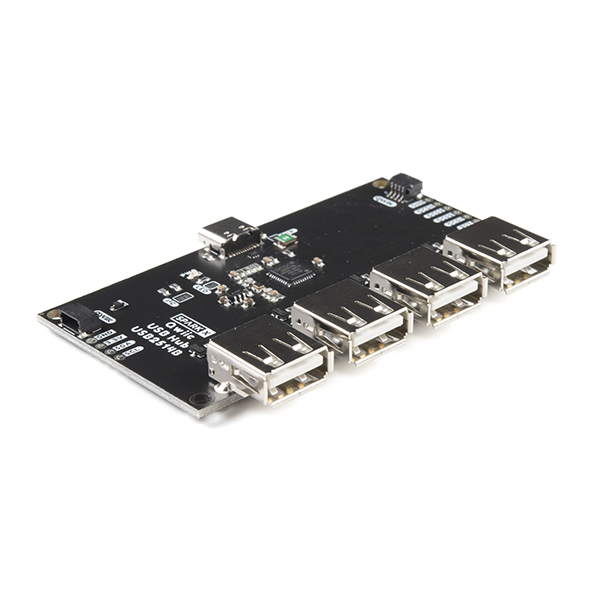Qwiic USB Hub - USB2514B
There are times when you have multiple USB devices in your prototype or device and you just want to plug in one cable. You need a built in USB hub!
The Qwiic USB Hub is a simple breakout board for the USB2514B USB hub IC. What gives it extra flair is the ability to configure the device over I2C. Out of the box, the board will appear as a standard USB 2.0 Hub; no configuration necessary. Closing the I2C jumper will put the device into configuration mode. We've got an Arduino Library to help you set the various parameters of the hub including VID/PID, downstream max current, even language ID and product names.
Known Issues: The power control MOSFETs on this version (x02) are not functional. While each port is on by default, they cannot be turned off in software.
Note: Once the configuration bytes are set and the USB2514B is told to 'attach' it will enumerate as a HUB and the configuration cannot be changed until the IC is reset.
Experimental Product: SparkX products are rapidly produced to bring you the most cutting edge technology as it becomes available. These products are tested but come with no guarantees. Live technical support is not available for SparkX products. Head on over to our forum for support or to ask a question.
- Schematic
- Eagle Files
- Arduino Library can be located in the Arduino IDE by searching 'SparkFun USB Hub'
- Microchip USB2514xB Datasheet
- Hardware repo
Comments
Looking for answers to technical questions?
We welcome your comments and suggestions below. However, if you are looking for solutions to technical questions please see our Technical Assistance page.
Customer Reviews
No reviews yet.






Anybody know if there are plans for a v3 that allows port power control in software? I haven't been able to find that capability in anything that costs less than $200, and I could really use this for some automated test ideas...
Hello. I am looking for a module that has this exact function elecrically, but has all physical interfaces on a 0.1" dupont header (or headers). Absolutely no USB type connectors. I will design a carrier board to make the physical connections, and I'd love to not have to put the hub circuitry on my board. Can you make a recommendation?
A version of this with usb-c out would be fantastic. I've been looking for a hub that lets me do usb pd to charge a device while simultaneously tapping the line to get 5V out for an embedded project.
I've been wanting sparkfun to put out a hub like this for a long time! Thank you SparkX. It would also be nice to be able to bypass the USB type C port on the back so that I can wire + and - directly but hey, I guess I can glue the cable to the port.